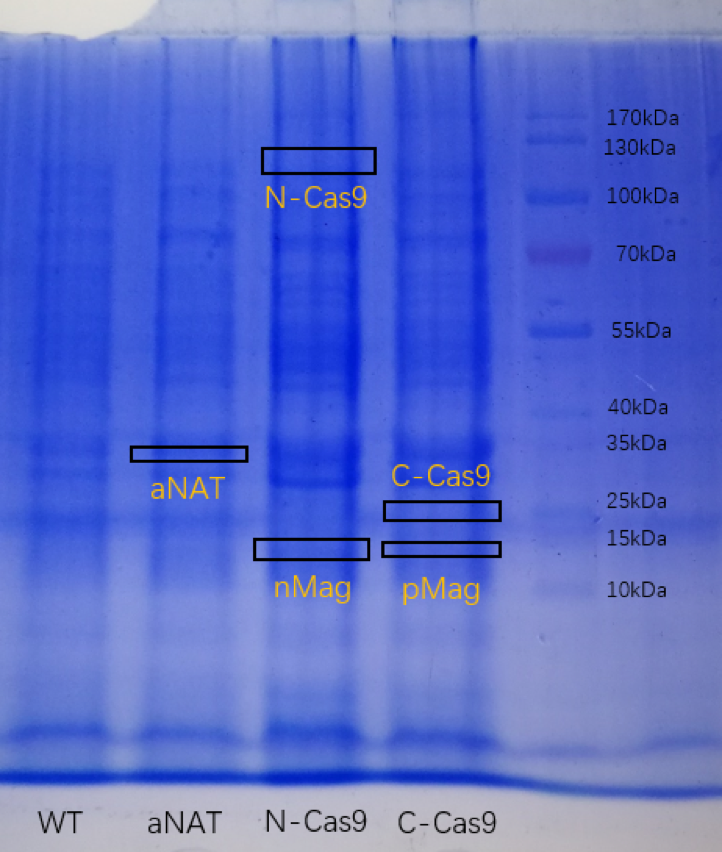Difference between revisions of "Part:BBa K3099001"
| Line 17: | Line 17: | ||
<partinfo>BBa_K3099001 parameters</partinfo> | <partinfo>BBa_K3099001 parameters</partinfo> | ||
<!-- --> | <!-- --> | ||
| + | <html> | ||
| + | <h1>aNAT</h1> | ||
| + | <h1>USTC</h1> | ||
| + | <p>After the azo dyes have been broken up, two molecules of aromatic amines generated which can restrict the growth of | ||
| + | the bacteria. The aNATs can transfer an acetyl group from substrates like Acetyl-CoA to the amidogen to form an | ||
| + | acylamino, thus the "active" hydrogen atom of the amidogen is substituted. Therefore the amidogen cannot damage the | ||
| + | growth of Shewanella Oneidensis MR-1. | ||
| + | <br> | ||
| + | This part was inserted into plasmid, and the correct construction of this recombinant plasmid was confirmed by PCR | ||
| + | identification and sequencing of the PCR products. | ||
| + | </p> | ||
| + | <div class="card" style="background-color: #fdfaf0; border: unset"> | ||
| + | <img class="card-img-top" src="https://2019.igem.org/wiki/images/e/e7/T--USTC--PCR_aNAT.png" alt="Card image"> | ||
| + | <div class="card-body"> | ||
| + | <p class="card-title" style=" text-align: center;">Figure1. Electrophoresis result PCR of aNAT | ||
| + | </p> | ||
| + | </div> | ||
| + | </div> | ||
| + | <p>The E.coli was grown in LB liquid medium, and obtain protein by heating them. The sample was electrophoresed on a | ||
| + | sodium dodecyl sulfate(SDS)-polyacrylamide gel, followed by Coomassie blue staining.( The pictures are blurred | ||
| + | because of the poor photographic equipment) | ||
| + | </p> | ||
| + | <div class="card" style="background-color: #fdfaf0; border: unset"> | ||
| + | <img class="card-img-top" src="https://2019.igem.org/wiki/images/1/14/T--USTC--SDS_PAGE.png" alt="Card image"> | ||
| + | <div class="card-body"> | ||
| + | <p class="card-title" style=" text-align: center;">Figure2. SDS-PAGE for strain expressing aNAT, C-Cas9+pMag | ||
| + | and N-Cas9+nMag. | ||
| + | </p> | ||
| + | </div> | ||
| + | </div> | ||
| + | <p>Besides, we cultivate the Shewanella which has the aNATs and the WT in mineral salt medium containing sulfanilamide | ||
| + | (a kind of aromatic amines). | ||
| + | <br> | ||
| + | From Figure3, we can see the result significantly demonstrates that the ability of S.oneidensis with aNAT in 40ug/mL | ||
| + | sulfanilamide is higher than wild type and empty pYYDT controlling groups. The shaking of aNAT and empty pYYDT | ||
| + | growing curves is possibly because of the lack of nutrition in aerobic mineral salt medium, and the pressure of | ||
| + | kanamycin makes the growth of bacteria with pYYDT unstable. | ||
| + | </p> | ||
| + | <div class="card" style="background-color: #fdfaf0; border: unset"> | ||
| + | <img class="card-img-top" src="https://2019.igem.org/wiki/images/8/85/T--USTC--aNAT_cur.png" alt="Card image"> | ||
| + | <div class="card-body"> | ||
| + | <p class="card-title" style=" text-align: center;">Figure3. Growth curve of Shewanella with aNAT | ||
| + | </p> | ||
| + | </div> | ||
| + | </div> | ||
| + | <h5>Reference</h5> | ||
| + | <p>[1]: Cocaign A, Bui LC, Silar P, et al. Biotransformation of Trichoderma spp. and their tolerance to aromatic amines, | ||
| + | a major class of pollutants. Appl Environ Microbiol. 2013;79(15):4719–4726. doi:10.1128/AEM.00989-13 | ||
| + | </p> | ||
| + | </html> | ||
Latest revision as of 23:09, 21 October 2019
aNAT
After the azo dyes have been broken up, two molecules of aromatic amines generated which can restrict the growth of the bacteria. The aNATs can transfer an acetyl group from substrates like Acetyl-CoA to the amidogen to form an acylamino, thus the "active" hydrogen atom of the amidogen is substituted. Therefore the amidogen cannot damage the growth of Shewanella Oneidensis MR-1
Sequence and Features
- 10COMPATIBLE WITH RFC[10]
- 12COMPATIBLE WITH RFC[12]
- 21COMPATIBLE WITH RFC[21]
- 23COMPATIBLE WITH RFC[23]
- 25COMPATIBLE WITH RFC[25]
- 1000COMPATIBLE WITH RFC[1000]
aNAT
USTC
After the azo dyes have been broken up, two molecules of aromatic amines generated which can restrict the growth of
the bacteria. The aNATs can transfer an acetyl group from substrates like Acetyl-CoA to the amidogen to form an
acylamino, thus the "active" hydrogen atom of the amidogen is substituted. Therefore the amidogen cannot damage the
growth of Shewanella Oneidensis MR-1.
This part was inserted into plasmid, and the correct construction of this recombinant plasmid was confirmed by PCR
identification and sequencing of the PCR products.

Figure1. Electrophoresis result PCR of aNAT
The E.coli was grown in LB liquid medium, and obtain protein by heating them. The sample was electrophoresed on a sodium dodecyl sulfate(SDS)-polyacrylamide gel, followed by Coomassie blue staining.( The pictures are blurred because of the poor photographic equipment)

Figure2. SDS-PAGE for strain expressing aNAT, C-Cas9+pMag and N-Cas9+nMag.
Besides, we cultivate the Shewanella which has the aNATs and the WT in mineral salt medium containing sulfanilamide
(a kind of aromatic amines).
From Figure3, we can see the result significantly demonstrates that the ability of S.oneidensis with aNAT in 40ug/mL
sulfanilamide is higher than wild type and empty pYYDT controlling groups. The shaking of aNAT and empty pYYDT
growing curves is possibly because of the lack of nutrition in aerobic mineral salt medium, and the pressure of
kanamycin makes the growth of bacteria with pYYDT unstable.

Figure3. Growth curve of Shewanella with aNAT
Reference
[1]: Cocaign A, Bui LC, Silar P, et al. Biotransformation of Trichoderma spp. and their tolerance to aromatic amines, a major class of pollutants. Appl Environ Microbiol. 2013;79(15):4719–4726. doi:10.1128/AEM.00989-13
